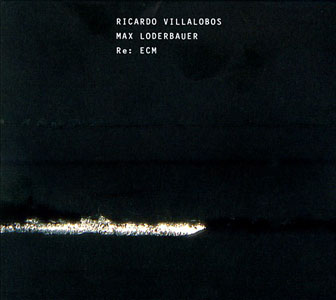Home » Jazz Articles » Extended Analysis » Ricardo Villalobos / Max Loderbauer: Ricardo Villalobos ...
Ricardo Villalobos / Max Loderbauer: Ricardo Villalobos / Max Loderbauer: Re: ECM
The concept of remix isn't new to ECM either; when the iconic Munich-based label released Norwegian trumpeter Nils Petter Molvaer's groundbreaking Khmer in 1997, the first edition included a bonus second disc of remixes. Despite its reputation for exploring largely acoustic environs, ECM's own soundscape creation during the mixing process—in addition to joining modern electronic compositional techniques with centuries old music on albums like Being Dufay (2009)—means that the remix building blocks are far from foreign to the label, or its owner, producer Manfred Eicher.
With a discography of more than 1,000 releases covering more stylistic ground than any independent label in history, it's no surprise that an album like Re: ECM has hit the shelves; what's surprising, perhaps, is that it's taken this long. Ricardo Villalobos—a longtime ECM fan—has been experimenting with music from the label for many years, looking to bring together "the functionality of reduced electronic structures with the living textures of ECM productions," to "ignite new passions on a subliminal level." For Re: ECM, the Chilean electronic music producer collaborates with techno circle star Max Loderbauer for a set of seventeen sound structures, using source material from the label's classical side, its more definitively jazz side, and one artist, pianist Christian Wallumrod, who occupies a space somewhere in-between.
The austere Wallumrød is, in fact, Villalobos and Loderbauer's most called-on source—the other is composer Alexander Knaifel, who is remixed four times—with "Music for One Cat," from 2007's The Zoo is Far , becoming "Recat," Giovanna Pessi's Baroque harp gradually emerging from a delicate but throbbing bass synth and a soft yet persistent series of electronic pulses. The Norwegian pianist's Fabula Suite Lugano (2010) is referenced even more often, with each of Re: ECM's two discs bookended by two tracks, including "Blop," which opens the first disc with an atmospheric landscape focusing initially on Wallumrød's spare pianism ("Reblop"), but a second more dominated, once again, by Pessi ("Replob"). Gjermund Larsen's Hardanger fiddle on "Quote Funebre" is doubled by an otherworldly synth texture, while a single, reverb-driven bass drum provides a repetitive rhythmic anchor.
An electronic pulse, taken at a faster tempo, and a spacious audioscape filled with interspersed snippets, render guitarist John Abercrombie's enduring title track from 1975's Timeless largely unrecognizable, while Bennie Maupin's "Ensenada," from his classic The Jewel in the Lotus (1974), becomes "Rensenada," one of Re: ECM's best tracks, its tranquil, marimba-heavy ambience turned more jagged, dense and dynamic over the course of nearly eleven minutes. "Rekondakion," too, is an album highlight, Arvo Pärt's composition for chamber choir turning more ethereal, its angelic voices sonically recontextualized to sound like a cross between György Ligeti's "Lux Aeterna" and Gavin Bryars' "The Sinking of the Titanic." Paul Giger's "Karma Shadub," from Ignis (2000), is augmented with layers of percussion (sampled snare drum, cymbals and more) without actually receiving a pulse on "Reshadub," while the reverb-drenched lyricism of Stefano Bollani's pianism on drummer Paul Motian's "Birdsong," from their 2005 collaboration with trumpeter Enrico Rava (Tati), is buried amidst unpredictable swells of low-register sonics.
Whether it's taking an existing extended concept like reed multi-instrumentalist Louis Sclavis' already near- unrecognizable playing on Imparfait des langues's "Annonce," from 2007, and giving its Middle Eastern veneer an appropriate rhythmic underpinning, or replacing pianist Wolfert Brederode's inherent lyricism on Currents (2008) with something altogether darker and more sinuous, Villalobos and Loderbauer have found ways to explore the smallest corner of ECM's catalog, bridging its vast stylistic landscape and creating a work that's reverential yet absolutely stands on its own as a new and compelling piece of work. Hopefully the absence of Volume One as a subtitle doesn't mean this is the end of Re: ECM.
Track Listing
CD1: Reblop (source: Christian Wallumrød Ensemble, Fabula Suite Laguna (2009)); Recat (source: Christian Wallumrød, The Zoo is Far (2007)); Resvete (source: Alexander Knaifel, Svete Tikhiy (2003)); Retimeless (source: John Abercrombie, Timeless (1975)) ; Reemergence (source: Miroslav Vitous, Emergence (1985)); Reblazhenstva (source: Alexander Knaifel, Blazhenstva (2008)); Reannounce (source: Louis Sclavis, L'Imparfait des Langues (2007));Recurrence (source: Wolfert Brederode Quartet, Currents (2007)); Requote (source: Christian Wallumrød, Fabula Suite Laguna (2009)). CD2: Replob (source: Christian Wallumrød, Fabula Suite Laguna (2009)); Reshadub (source: Paul Giger, Ignis (2000)); Rebird (source: Rava/Bollani/Motian, Tati (2005)); Retikhiy (source: Alexander Knaifel, Svete Tikhiy (2003)); Rekondakion (source: Arvo Pärt, Kanon Pokajanen (1998)); Rensenada (source: Bennie Maupin, The Jewel in the Lotus (1974)); Resole (source: Alexander Knaifel, Svete Tikhiy (2003)/Amicta Sole (2005)); Redetach (source: Christian Wallumrød, Fabula Suite Laguna (2009)).
Personnel
Ricardo Villalobos: electronics; Max Loderbauer: electronics.
Album information
Title: Ricardo Villalobos / Max Loderbauer: Re: ECM | Year Released: 2011 | Record Label: ECM Records
< Previous
Mary Joyce Project: Nothing To Lose
Comments
About Ricardo Villalobos / Max Loderbauer
Related Articles | Concerts | Albums | Photos | Similar ToTags
For the Love of Jazz
 All About Jazz has been a pillar of jazz since 1995, championing it as an art form and, more importantly, supporting the musicians who create it. Our enduring commitment has made "AAJ" one of the most culturally important websites of its kind, read by hundreds of thousands of fans, musicians and industry figures every month.
All About Jazz has been a pillar of jazz since 1995, championing it as an art form and, more importantly, supporting the musicians who create it. Our enduring commitment has made "AAJ" one of the most culturally important websites of its kind, read by hundreds of thousands of fans, musicians and industry figures every month.



















